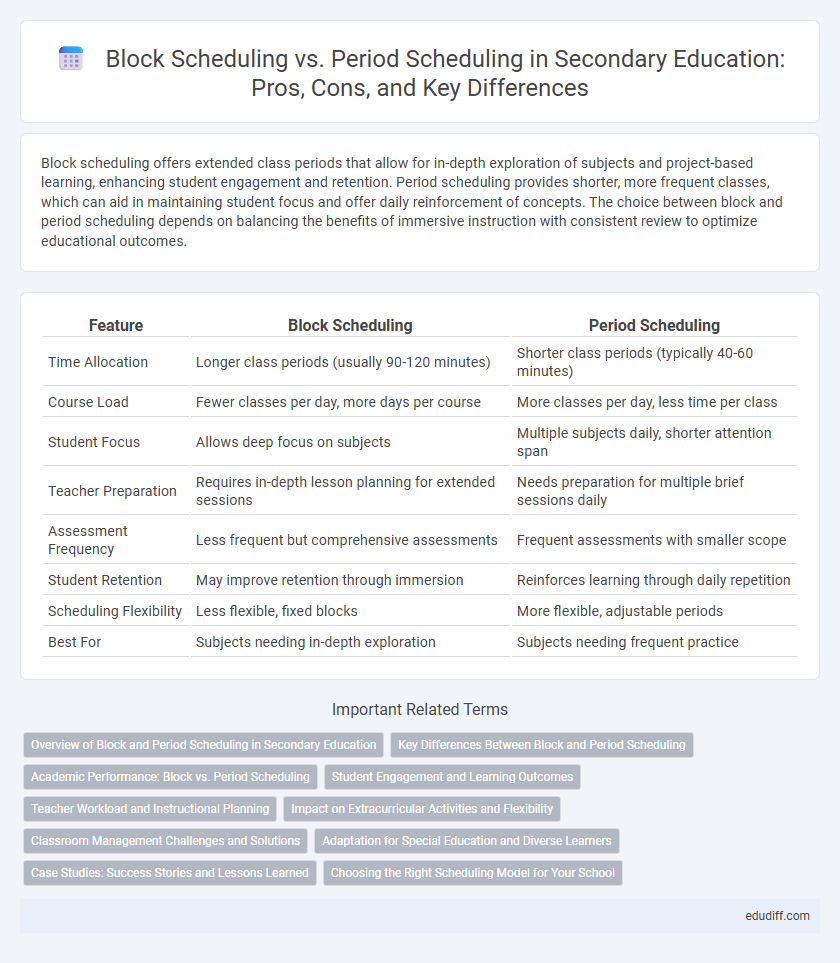Block scheduling offers extended class periods that allow for in-depth exploration of subjects and project-based learning, enhancing student engagement and retention. Period scheduling provides shorter, more frequent classes, which can aid in maintaining student focus and offer daily reinforcement of concepts. The choice between block and period scheduling depends on balancing the benefits of immersive instruction with consistent review to optimize educational outcomes.
Table of Comparison
| Feature | Block Scheduling | Period Scheduling |
|---|---|---|
| Time Allocation | Longer class periods (usually 90-120 minutes) | Shorter class periods (typically 40-60 minutes) |
| Course Load | Fewer classes per day, more days per course | More classes per day, less time per class |
| Student Focus | Allows deep focus on subjects | Multiple subjects daily, shorter attention span |
| Teacher Preparation | Requires in-depth lesson planning for extended sessions | Needs preparation for multiple brief sessions daily |
| Assessment Frequency | Less frequent but comprehensive assessments | Frequent assessments with smaller scope |
| Student Retention | May improve retention through immersion | Reinforces learning through daily repetition |
| Scheduling Flexibility | Less flexible, fixed blocks | More flexible, adjustable periods |
| Best For | Subjects needing in-depth exploration | Subjects needing frequent practice |
Overview of Block and Period Scheduling in Secondary Education
Block scheduling in secondary education typically involves longer class periods, ranging from 70 to 120 minutes, allowing students to engage in more in-depth learning and hands-on activities. Period scheduling features shorter, 40 to 60-minute classes spread throughout the day, enabling exposure to multiple subjects but potentially limiting extended focus on complex topics. Research indicates block scheduling can improve student engagement and reduce transition time, while period scheduling maintains traditional structure and daily routine consistency.
Key Differences Between Block and Period Scheduling
Block scheduling divides the school day into fewer, longer classes, typically 90 minutes each, while period scheduling features multiple shorter classes, usually 45-55 minutes. Block scheduling promotes in-depth learning and reduces daily transitions, whereas period scheduling offers more frequent breaks and exposure to diverse subjects each day. The choice impacts instructional time, student attention span, and course pacing significantly in secondary education.
Academic Performance: Block vs. Period Scheduling
Block scheduling often enhances academic performance by allowing students extended time for in-depth exploration of subjects, leading to improved retention and understanding. Period scheduling, with shorter and more frequent classes, may benefit subjects requiring regular reinforcement but can limit deeper engagement. Research indicates block scheduling tends to improve achievement in subjects like science and mathematics, where extended periods facilitate complex concepts and hands-on activities.
Student Engagement and Learning Outcomes
Block scheduling increases student engagement by allowing extended periods for in-depth exploration of subjects, promoting active learning and critical thinking. Period scheduling, with shorter class times, often results in frequent transitions that can disrupt focus and reduce time for mastery of complex concepts. Studies show that block scheduling improves learning outcomes by facilitating project-based activities and personalized instruction, enhancing retention and academic performance.
Teacher Workload and Instructional Planning
Block scheduling reduces teacher workload by allowing longer class periods, which streamline lesson planning and enable more in-depth instructional delivery. Period scheduling requires teachers to prepare multiple distinct lessons daily, increasing preparation time and complexity. Effective instructional planning benefits from block scheduling's extended periods, promoting comprehensive coverage and better pacing of curriculum content.
Impact on Extracurricular Activities and Flexibility
Block scheduling offers extended class periods that enable deeper engagement in extracurricular projects and flexible time management, benefiting students who balance academics with activities like sports or arts. In contrast, period scheduling segments the day into shorter intervals, often limiting the available time for extracurricular commitments and reducing flexibility for student participation. Schools adopting block scheduling often report increased student involvement and improved time allocation for both academic and non-academic pursuits.
Classroom Management Challenges and Solutions
Block scheduling reduces the frequency of class transitions, minimizing disruptions and allowing teachers to implement deeper instructional strategies, but it may pose challenges in maintaining student focus during extended periods. Period scheduling offers more frequent breaks, which can help manage student attention spans but increases class transitions that potentially lead to more interruptions and logistical management issues. Effective classroom management in block scheduling requires strategic lesson pacing and varied activities to sustain engagement, while period scheduling benefits from clear routines and time management techniques to maximize productivity within shorter class segments.
Adaptation for Special Education and Diverse Learners
Block scheduling offers extended class periods that allow special education and diverse learners more time for individualized instruction, hands-on activities, and therapeutic interventions, enhancing comprehension and engagement. Period scheduling, with shorter class durations, can limit opportunities for deep exploration and personalized support but may benefit students requiring varied and frequent transitions. Adapting block scheduling to include targeted support strategies can significantly improve academic outcomes and accommodate diverse learning needs in secondary education.
Case Studies: Success Stories and Lessons Learned
Case studies on block scheduling reveal improved student engagement and higher test scores in secondary schools compared to traditional period scheduling, highlighting success in deeper curriculum understanding and reduced transition time. However, some schools reported initial adjustment challenges, such as longer class fatigue and planning demands on teachers, emphasizing the need for targeted professional development. Lessons learned across multiple districts underscore the importance of flexible implementation and ongoing evaluation to maximize academic and behavioral outcomes.
Choosing the Right Scheduling Model for Your School
Block scheduling offers longer class periods, enabling in-depth exploration of subjects and project-based learning, which can enhance student engagement and retention. Period scheduling features shorter, more frequent classes, supporting a wider variety of subjects daily and consistent reinforcement of concepts. Schools must evaluate factors such as curriculum goals, teacher readiness, and student learning styles to determine the most effective scheduling model.
Block Scheduling vs Period Scheduling Infographic

 edudiff.com
edudiff.com